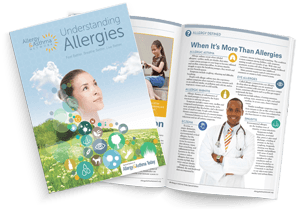Allergies to Dogs, Cats, & Pets
- Home
- |
- A Complete Guide to Allergies
- |
- Allergies to Dogs – Cats...
What causes pet allergies?
Allergic reactions to cats, dogs and other furry animals are caused by proteins found in flecks of the pets’ skin, called dander, as well as in their saliva and urine. These tiny proteins can hang suspended in the air for a long time, settle in furniture, rugs and house dust that circulates throughout your home. You are really not allergic to the fur of your pet. You are allergic to pet dander.
What are the symptoms of pet allergies?
Pet allergens can cause reactions when they’re inhaled, get in the eyes, or come in contact with skin. Just walking into a room where a cat or dog has been could cause symptoms. Touching the animal or being licked may cause itching and hives. Reactions can happen within minutes or may be delayed for hours after exposure.
How do you prevent pet allergy symptoms?
Finding a new home for the pet is the most effective way to reduce levels of pet allergens in the home.
If you choose this option, keep in mind that once the cat or dog is removed from the home, symptoms may not improve for weeks or even months, as allergen levels fall quite slowly. Professional cleaning may help, and you can speed things along by making extensive environmental changes, such as removing carpets and upholstered furniture.
Can you live with a pet if you are allergic to it?
For most pet owners finding a new home for a beloved pet is a difficult choice, especially when there’s an emotional attachment to their animal.
Taking allergy medication, especially when you know you’re going to be exposed to pets or animals, is one option to discuss with your allergist.
The following lifestyle recommendations may also help:
- Restrict pets to one area of the home when inside.
- Always keep pets out of the bedroom.
- Cover beds and pillows with allergen-proof encasings. It’s often extremely difficult to remove pet allergens that may have gotten into mattresses, box springs and pillows.
- Use a HEPA-filter vacuum daily, especially in rooms where the person with pet allergies spends the most time. Consider a HEPA air cleaner for the bedroom.
- Replace carpets, upholstered furniture, heavy drapes and other allergen and dust collectors with hardwood floors or washable furnishings. Focus on the bedroom – even though you should not allow your pet in this room, animal allergens can still travel through air and on your clothes.
Washing your cat or dog is not likely to result in any significant difference in allergens. Research shows the benefits of washing are so temporary that it is unlikely to be worth the effort or distress to the pet.

Get a Free Copy of Our "Understanding Allergies" Guide ➤
What breeds of dogs or cats are hypoallergenic?
There is no breed of cat or dog that is hypoallergenic because they all shed dander. Some breeds may produce fewer allergens than others, however.
Does immunotherapy work for pet allergies?
Allergen immunotherapy, also known as allergy shots, can help build a patient’s tolerance to pet allergens, reducing or eliminating symptoms.
Here’s how it works: the patient is given a gradually increasing amount of the allergen on a regular schedule, until a maintenance level is reached. Tolerance for the allergen typically continues after immunotherapy ends – however the long-term success rate can vary from person to person.
Talk with your allergist about whether immunotherapy is right for you.

Are there other conditions that can look like or complicate allergies
There are other types of conditions that can mimic allergies, but are different than an IgE-mediated allergy. The symptoms, diagnosis and treatment can vary depending upon the condition. Here are some of them.
Food-related conditions that can have symptoms similar to food allergies include:
Visit Our Other Pages for More Allergy Information, Webinars, Posters, Infographics, and more!
Assistance Programs for Medications
Allergy Online Store
Allergy Posters
Allergy Webinars
Allergy News
Allergy Facts
Allergy Dictionary
Allergy Medication & Treatment
See Related Pages
- Symptoms of Allergies
- Hives
- Allergy Diagnosis and Testing
- How are Allergies Treated?
- Nasal Allergy, Rhinitis and Allergic Rhinitis
- What if I Can’t Afford My Allergy Medications?
- Pregnancy and Allergies
- Pollen Allergy
- Eye Allergies – Allergic Conjunctivitis
- Mold Allergy
- Allergies to Dogs – Cats – Pets
- Allergy to Dust Mites
- Cockroach and Mice Allergy
- Insect Allergy
- Drug Allergy
- Complete Guide to Latex Allergy
- Allergy Statistics in the US
- Allergy Dictionary
- Allergy Webinars
